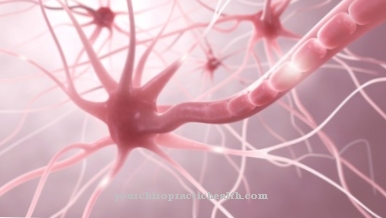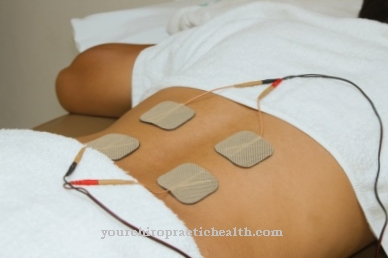In the Electrical stimulation a motor nerve is contacted by means of applied voltage. Through this contact, the muscle reaches an action potential that causes it to contract. Therapeutic electrical stimulation is mainly used for peripheral paralysis and is intended to prevent atrophy of the muscles.
What is electrical stimulation?

The electrical stimulation is a therapeutic stimulation by an applied voltage source. Electrostimulative procedures are mainly used in the case of nerve failures. When peripheral nerves in the body fail, the muscle cells in the area supplied by the paralyzed nerve often break down, especially on the arms and legs.
This breakdown is related to the fact that the muscles cannot get electrical signals through the nerve. The signals from the nerve can be replaced by electro-stimulating therapies. In such a therapy session, attached electrodes send out small current surges into the tissue and thus control the affected nerve. When activated, the endangered muscle receives stimulating signals that cause muscle contraction. Because of the contractions that are brought about in this way, ideally no atrophy of the paralyzed muscle occurs.
Human muscles respond differently to different types of current modulation. In most cases, voltage curves with an exponential curve are best suited for electrical stimulation. In addition to this area of application, the therapeutic measures are also used on men with anejaculation in order to stimulate ejaculation.
Function, effect & goals
Functional electrical stimulation corresponds to the electrical stimulation of a specific muscle or muscle group. The process can take place directly or indirectly. The electrical signal stimulates motor nerves, which trigger muscle contraction.
An implanted functional electrical stimulation takes place with a pacemaker, for example. Depending on the respective damage, the regularly stimulating signal from the pacemaker excites the heart muscle in the area of the right atrium or in the region of the right ventricle. The respiratory pacemaker is also based on implanted functional electrical stimulation and mainly stimulates the phrenic nerve. Other areas of application of the implanted form are the intestinal pacemaker and the bladder pacemaker, which stimulate the muscles involved in the excretion to contract. Another field of application of electrical stimulation opens up with the cochlear implant for the hearing impaired.
The implant electrically stimulates the auditory nerve and enables hearing even after severe hearing loss. This type of electrical stimulation stimulates different regions of the basilar membrane and thus stimulates the ganglion cells in the hearing organ. Every nerve stimulation requires an applied field strength with a certain gradient strength that can trigger an action potential in the contacted nerve. The potential released in this way travels along the motor nerve to the motor end plate of a muscle. The stimulation again triggers an action potential on the muscle, thereby causing the targeted muscle to contract. However, muscle cells can also be stimulated directly.
Electrical stimuli for direct muscle stimulation are much larger and last a lot longer than those for stimulating certain nerves. Surface electrodes are placed on the patient's skin for both nerve and muscle electrical stimulation. Usually, these measures take place within a rehabilitation facility. By means of changes in the stimulus frequency, the individual areas of the muscle fibers are stimulated in different strengths during electrical stimulation. Frequencies up to 200 Hz activate the fast muscle fibers in particular. Those up to 10 Hz improve the endurance of the slow muscle fibers.
Direct muscle electrical stimulation corresponds to training and can therefore also take place on top athletes, for example. The meanwhile effective application of direct muscle electrical stimulation refers to denervated muscles after permanent peripheral paralysis and uses impulses of up to 300 MS width. The intensities of the stimulation reach up to 250 mA.
You can find your medication here
➔ Medicines for muscle weaknessRisks, side effects & dangers
As a therapeutic method, electrical stimulation is associated with some risks and side effects. A person's body is sensitive to electrical currents. For this reason, even small voltages below 40 volts can cause negative effects if they are applied under unfavorable conditions.
These unfavorable conditions include, for example, highly conductive sweat. In individual cases, electrical stimulation can cause injuries such as minor burns or functional impairment of the peripheral nerves. Since improper use can impair the conduction of the cardiac muscle cells, life-threatening cardiac arrhythmias can occur in extreme cases. In the context of direct muscle stimulation, pain can also occur as side effects of electrical stimulation. Some patients experience low-frequency electrical stimulation only as an unpleasant pull.
Others complain of extremely painful sensations. In patients without appropriate innervation, these side effects take care of themselves. All other patients are now mostly treated with medium-frequency electricity for direct muscle stimulation, which corresponds to frequencies above 1000 Hz and is not sensitive to stress. The electrical resistance to electrical stimuli is frequency-dependent in inverse proportionality. According to experience, frequencies of around 2,000 Hz are particularly effective in modulated currents. Modulated medium frequency is already used in a standardized manner by certain therapy devices and training systems. Both the electrical stimulation of nerves and the stimulation of muscles can cause skin rashes in the area of the activated electrodes. As a rule, such rashes are reversible and disappear after a few hours.
However, patients with allergies to certain adhesives should report these allergies to their therapist. In absolutely exceptional cases, sensory disturbances remain on the skin after electrical stimulation, which lead to permanent abnormal sensations. Such abnormal sensations can correspond, for example, to persistent numbness or a disorder of feeling warm and cold. Despite the possible risks, most patients tolerate electrical stimulation well. Some even find the impulses relaxing.






.jpg)

















.jpg)



